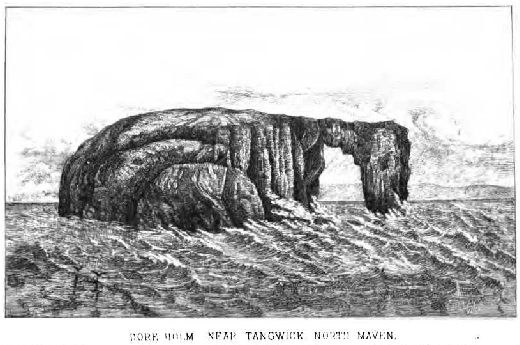|
ROENESS VOE TO HAMNA VOE.
Wonderful Effects of the
Sea—Grind of the Navir—Villians of Ure—Holes of Scraada—The Cannon.
THE ragged coast between
the Voe of Roeness, and that of Hamna, is much indented by deep gios,
but, otherwise, is devoid of interest. The fine rooks of Ossa Skerry,
more than a mile off the shore, tend greatly to relieve the eye as it
gazes over the vast expanse of ocean. They are tenanted by numerous
gulls. The extensive tract of country between the two voes is so bleak
and bare as to merit as little attention as its sea-shore. The safe
little bay of Hamna Voe, which runs into the land for about a mile,
forms a good fishing-station. Its shores had the honour of giving birth
to John Williamson, the great innoculator of last century, whose
wonderful success in averting the ravages of small-pox I have had
occasion to refer to in another part of this little work. The bones of
good old “Johnny Notions” lie in the churchyard of Braken, close by.
The great peninsula of
Northmavine contains a good many tributary peninsulas, several of which
we have had occasion to notice. We now come to the most interesting of
all. Hamna Voe, entering the land from the north-east, goes far to meet
Braewick, which enters from the south, and between them a peninsula is
formed. On viewing the coast, no one of the least reflection can fail to
"be struck by the evidences that are everywhere observable of the
tremendous force of the ocean. While the cause of this wonderful
phenomenon has ever been the same, its effects present the most singular
variety. The chief reason for this variety has evidently been the
greater or less cohesive force, inherent in the different rocks.
Let us see some of the
effects of the sea. At one place the great Atlantic, after battering
against the iron-bound coast for ages, with the force of its mighty
artillery, has cut for itself a passage through a precipice of porphyry,
termed the Grind of the Navir. The accompanying engraving conveys a
better idea of this extraordinary place than any description that could
be attempted. The pieces of rocks which the sea has cleared away in
forming the Grind, are remarkable, not only for size, but for the
distance to which they have been borne. They are cubical in shape,
several tons in weight, and have been carried about one hundred and
eighty feet from their beds, and piled into two or three immense heaps.
Inland from the Grind of
the Navir, is a long stretch of level plain, crowned by beautiful, soft,
velvety turf Dr Hibbert thus eloquently describes it:—“The verdure that
embroiders this proud bank, on which numerous sheep continually feed,
pleasingly harmonises, on a calm day, with the glassy surface of the
wide Atlantic; nor is the pleasure less perfect when the smooth coating
of so luxuriant a green turf is contrasted with the naked red crags that
form the precipice below, whitened with the spray of the breakers which
continually dash against them with angry roaring. The rich surface of
pasture that thus gradually shelves from the elevated ridge of the coast
bears the name of the Villians of Ure: and well might we apply to this
favoured spot of Thule the compliment that has often been paid to some
rich vale of England—‘ Fairies joy in its soil.’ ”
Nowhere could a more
delightful promenade be found, and no sport in Shetland is more
enjoyable than a scamper over this plain on pony-back. Such an excursion
should not, however, be undertaken without a guide, or a good knowledge
of the country, for, not many hundred yards from the Grind, we come
suddenly upon two immense perforations in the earth. They look like two
huge quarry holes, but their sides are precipitous, and well blackened
by an atmosphere loaded with sea salts. A natural bridge, covered by
green sward, separates them above, but its great archway unites the two
Holes of Scraada1—for that is their name—beneath. But the stranger
arrives at the crowning wonder of all when he discovers that the bottom
of both the “Holes” is filled with sea-water. The sea enters through a
cavernous tunnel, about 100 yards long. It is most interesting to stand
on the bridge, which spans this mighty chasm, and see the surf beat on
the beach of the inner “ Hole,” while, at that point, the bum from the
Loch of Houland, not far off, throwing itself over the precipice sixty
or eighty feet high, descends in an angry vat erf all, as if to oppose
the entrance of brine into its subterranean abode. This view must be
more astonishing still during a winter storm, for, when the wild waves
are rushing in, impelled by the unimpeded fury of the western blasts,
the vexed waters, forced through the lengthened cavern’s jaws, are said
to spring upwards in a lofty column from the inland gulf. There is thus,
at the same time and place, a continuous cataract of river water, and an
ascending spire of a more intermittent nature from the briny deep.” A
whale is said on one occasion to have made its way into this strange
subterranean sea. Its fate is not recorded, but we shall presume it
never returned to the ocean.

Not far from the mouth of
the tunnel leading to the Holes of Scraada is an aperture in the cliff,
called the Cannon. It apparently communicates with a wider chamber
concealed in the rock. With a strong wind, a quantity of spray is blown
into the chamber; the air is in the meantime condensed, but rebounding
through its natural elasticity, it forces the water out again with a
loud noise, and a copious discharge of fine foam, not unlike the report
and smoke of a piece of ordnance. |

